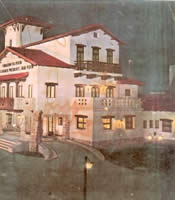 The
Ciudad Estudiantil was located next to the Children’s City in the
Buenos Aires suburb of Belgrano. It took up four city blocks: Echeverría,
Ramsay, Dragones, and Blanco Encalada. The
Ciudad Estudiantil was located next to the Children’s City in the
Buenos Aires suburb of Belgrano. It took up four city blocks: Echeverría,
Ramsay, Dragones, and Blanco Encalada.
It was organized in the same way as the Hogar Escuelas. Students were
transported to their secondary (high) schools each day in Fundacion buses
and received tutoring if needed when they returned to the Student City
at the end of the school day. Classes were also taught at the Student
City and special emphasis was placed on instruction in the latest advances
in technology to ensure they were prepared to be successful in the modern
world. The instruction the students received at the Student City was far
ahead of what most secondary establishments offered; when the military
closed the City after the 1955 coup d’etat, many students were offered
scholarships in other countries eager to take advantage of their skills.
Both the Ciudad Infantil and the Ciudad Estudiantil were ahead of their
time. The purpose of the Ciudad Estudiantil was not only to funcion as
a Hogar Escuela for adolescents in need but also to prepare future leaders
from among the working classes by involving them in the decision-making
process of governing the Ciudad Estudiantil.
All students were male. Since the Fundacion did not yet have a Ciudad
Estudiantil for females, adolescent girls continued to be under the protection
of the Hogares Escuelas; they received food, clothes, medical attention,
tuition to secondary schools, books, supplies, everything they needed
to complete their secondary schooling (the only condition was that they
had to pass all their classes, but tutoring was always available).
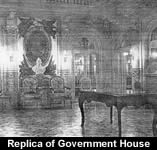 The
City contained replicas of the offices in the Casa Rosada (where the President
worked but did not live). Students chose a president, ministers and diplomats
who were encouraged to offer suggestions and constructive criticism. Everyone
had a job to do, from welcoming newcomers and helping them to adapt to
the City or forming part of the nightly security patrol to holding an
elective office. Based on his personality, an adolescent might have his
own room or share a room with one or two other students. Students were
responsible for maintaining order in their own rooms and for looking presentable.
Even though the Fundacion provided for all their needs, they had to shine
their own shoes and wait on themselves in the dining room. The
City contained replicas of the offices in the Casa Rosada (where the President
worked but did not live). Students chose a president, ministers and diplomats
who were encouraged to offer suggestions and constructive criticism. Everyone
had a job to do, from welcoming newcomers and helping them to adapt to
the City or forming part of the nightly security patrol to holding an
elective office. Based on his personality, an adolescent might have his
own room or share a room with one or two other students. Students were
responsible for maintaining order in their own rooms and for looking presentable.
Even though the Fundacion provided for all their needs, they had to shine
their own shoes and wait on themselves in the dining room.
“They were to work towards the common good of the community but
not let themselves become the tool of someone else’s ambition,”
Evita told them, repeating an idea often expressed by Perón.
Much importance was given to Physical Education and sports. The City’s
“Clubs” took up two blocks and students had the right to belong
to one gym and two sports clubs: soccer, sword fighting, basketball, calisthenics,
running, swimming,diving, water polo, etc. A stadium, a barber shop, and
locker rooms completed the complex.
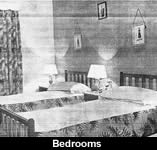 The
other two city blocks contained eight buildings which housed a dining
room, a “bar,” (which only served milk), a living The
other two city blocks contained eight buildings which housed a dining
room, a “bar,” (which only served milk), a living 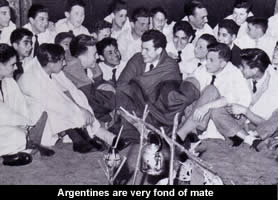 room,
the bedrooms (for one, two, or a maximum of three students). room,
the bedrooms (for one, two, or a maximum of three students).
The students were a diverse group; they ranged from the sophisticated
natives of Buenos Aires, the porteños, to their country cousins
of the far North (Salta, Jujuy) and South (La Patagonia) and every effort
was made to integrate them using the common denominator of their Argentine
nationality. Extra curricular activites such as bonfires and drama school
helped. Argentines are very fond of mate, the herbal tea much loved by
the legendary gauchos, which they drink from a gourd with a silver straw,
la bombilla. At night the students would gather around a bonfire. Hot
water was added to the loose tea leaves and the gourd was passed from
person to person, the water and tea replenished as needed. Once a year,
during the “Ceremonia del Mate,” students would choose the
person they considered to have been the friendliest and most helpful during
the year.
Evita supervised all the details. For instance, she rejected some imported
glasses bearing the words “Sweet Dreams” in English because
she wanted to encourage pride in Argentina’s cultural heritage.
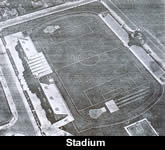 |
|
|
In 1952,
when her cortege was taken to Congress to lie in state, the students from
the Ciudad Estudiantil marched alongside the nurses of the Fundacion,
next to her coffin.
After the military coup d’etat of 1955, the students were evicted
and the buildings turned into a detention center to house the members
of government, arrested simply for being Peronistas. Later the Anti Infantile
Paralysis League took over the buildings.
Bibliography
Ferioli,
Néstor. La Fundación Eva Perón / 1. Buenos
Aires:Centro Editor de América Latina, 1990.
Fraser, Nicholas
& Marysa Navarro. Evita: The Real Life of Eva Perón.
New York: W.W. Norton & Company, 1996.
Ortiz, Alicia
Dujovne. Eva Perón. New York: St. Martin’s Press,
1996.
Fundación
Eva Perón. Eva Perón and Her Social Work. Buenos
Aires: Subsecretaria de Informaciones, 1950.
Fundación
Eva Perón. Cuidad Estudiantil. Buenos Aires: Subsecretaría
de Informaciones, 1954.
La Nación
Argentina: Justa, Libre, Soberana. Buenos Aires: Ediciones Peuser,
1950. |





